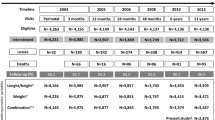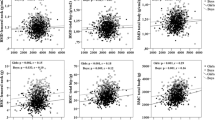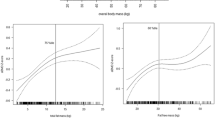Abstract
Summary
Growth in early life may predict adult bone health. Our data showed that greater height and body mass index (BMI) gain in utero and infancy are associated with higher peak bone mass, and greater BMI gain in childhood/adolescence with higher peak bone density. These associations are mediated by attained adult height and BMI.
Introduction
To study the relationship of height and BMI during childhood with adult bone mineral content (BMC), areal density (aBMD) and apparent density (BMAD, estimated volumetric density).
Methods
Participants comprised 565 men and women aged 33–39 years from the New Delhi Birth Cohort, India, whose weight and height were recorded at birth and annually during infancy (0–2 years), childhood (2–11 years) and adolescence (11 years–adult). Lumbar spine, femoral neck and forearm BMC and aBMD were measured using dual X-ray absorptiometry; lumbar spine and femoral neck BMAD were calculated.
Results
Birth length, and height and height gain during infancy, childhood and adolescence were positively correlated with adult BMC (p≤0.01 all sites except birth length with femoral neck). Correlations increased with height from birth to 6 years, then remained constant for later height measurements. There were no associations with BMAD. BMI at birth, and during childhood and adolescence was also positively correlated with BMC (p < 0.01 all sites). BMI at 11 years, and BMI gain in childhood and adolescence, were correlated with aBMD and BMAD (p < 0.001 for all); these correlations strengthened with increasing age of BMI measurement. The associations with height and BMI in early life became non-significant after adjustment for adult height and BMI.
Conclusions
Greater skeletal growth and BMI gain in utero and during infancy are associated with higher peak BMC, and greater BMI gain in childhood and adolescence is associated with higher peak aBMD and BMAD. These associations are mediated by the attainment of adult height and BMI, respectively.



Similar content being viewed by others
References
Consensus Development Conference (1991) Prophylaxis and treatment of osteoporosis. Osteoporosis Int 1:114–117
Cooper C (2003) Epidemiology of osteoporosis. In: Favus MJ (ed) Primer on the metabolic bone diseases and disorders of mineral metabolism, 5th edn. American Society for Bone and Mineral Research, Lippincott-Raven, Philadelphia, USA
Sambrook P, Cooper C (2006) Osteoporosis. Lancet 367:2010–2018
Cooper C, Campion G, Melton LJ 3rd (1992) Hip fractures in the elderly; a worldwide projection. Osteoporosis Int 2:285–289
Ralston SH (1998) Do genetic markers aid in risk assessment? Osteoporosis Int 8:S37–S42
Waugh EJ, Lam M-A, Hawker GA, McGowan J, Papaioannou A, Cheung AM, Hodsman AB, Leslie WD, Siminoski K, Jamal SA (2009) Risk factors for low bone mass in healthy 40–60 year old women: a systematic review of the literature. Osteoporosis Int 20:1–21
Hernandez CJ, Beaupre GS, Carter DR (2003) A theoretical analysis of the relative influences of peak BMD, age-related bone loss and menopause on the development of osteoporosis. Osteoporosis Int 14:843–847
Fujita Y, Iki M, Ikeda Y, Morita A, Matsukura T, Nishino H, Yamagami T, Kagamimori S, Kagawa Y, Yoneshimi H (2011) Tracking of appendicular bone mineral density for 6 years including the pubertal growth spurt: Japanese Population-based Osteoporosis Kids Cohorts Study. J Bone Mineral Res 29:208–216
Cooper C, Westlake S, Harvey N, Javaid K, Dennison E, Hanson M (2006) Developmental origins of osteoporotic fracture. Osteoporosis Int 17:337–347
Cooper C, Fall C, Egger P, Hobbs R, Eastell R, Barker D (1997) Growth in infancy and bone mass in later life. Ann Rheum Dis 56:17–21
Winsloe C, Earl S, Dennison EM, Cooper C, Harvey NC (2009) Early life factors in the pathogenesis of osteoporosis. Curr Osteoporos Rep 4:140–144
Dennison EM, Syddall HE, Sayer AA, Gilbody HJ, Cooper C (2005) Birth weight and weight at 1 year are independent determinants of bone mass in the seventh decade: the Hertfordshire cohort study. Pediatr Res 57:582–586
Baird J, Kurshid MA, Kim M, Harvey N, Dennison EM, Cooper C (2011) Does birth weight predict bone mass in adulthood? A systematic review and meta-analysis. Osteoporosis Int 22:1323–1334
Bhargava SK, Sachdev HPS, Fall CHD, Osmond C, Lakshmy R, Barker DJP, Dey Biswas SK, Ramji S, Prabharkaran D, Reddy KS (2004) Relation of serial changes in childhood body mass index to impaired glucose tolerance in young adulthood. New Eng J Med 350:865–875
Sachdev HPS, Fall CHD, Osmond C, Lakshmy R, Dey Biswas SK, Leary SD, Reddy KS, Barker DJP, Bhargava SK (2005) Anthropometric indicators of body composition in young adults: relation to size at birth and serial measurements of body mass index in childhood; the New Delhi birth cohort. Am J Clin Nutr 82:456–466
World Health Organization (1985) Energy and protein requirements. Report of a Joint FAO/WHO/UNU Expert Consultation. Technical Report Series No. 724. World Health Organization, Geneva
Carter D, Bouxsein ML, Marcus R (1992) New approaches for interpreting projected bone densitometry data. J Clin Endocrinol Metab 7:137–145
Lu PW, Cowell CT, LLoyd-Jones SA, Briody JN, Howman-Giles R (1996) Volumetric bone mineral density in normal subjects, aged 5–27 years. J Clin Endocrinol Metab 81:1586–1590
Gale CR, O’Callaghan FJ, Bredow M, Martyn CN, the Avon Longitudinal Study of Parents and Children Study Team (2006) The influence of head growth in fetal life, infancy, and childhood on intelligence at the ages of 4 and 8 years. Pediatrics 118:1486–1492
Adair LS, Martorell R, Stein AD, Hallal PC, Sachdev HPS, Prabhakaran D, Wills AK, Norris SA, Dahly DL, Lee NR, Victora CG, COHORTS group (2009) Size at birth, weight gain in infancy and childhood, and adult blood pressure in five low and middle income country cohorts: when does weight gain matter? Am J Clin Nutr 89:1383–1392
World Health Organization (2006) Child growth standards. Available at: http://www.who.int/childgrowth
Kaptoge S, da Silva JA, Brixen K, Reid DM, Kroger H, Nielsen TL, Andersen M, Hagen C, Lorenc R, Boonen S, de Vernejoul M-C, Stepan JJ, Adams J, Kaufman J-M, Reeve J (2008) Geographical variation in DXA bone mineral density in young European men and women. Results from the network in Europe on male osteoporosis (NEMO) study. Bone 43:332–339
Stein AD, Wang M, Martorell R, Norris SA, Adair LS, Bas I, Sachdev HPS, Bhargava SK, Fall CHD, Gigante DP, Victora CG, the COHORTS Group (2010) Growth patterns in early childhood and final attained stature: data from five birth cohorts from low and middle-income countries. Am J Human Biol 22:353–359
Amling M, Pogoda P, Beil FT, Schilling AF, Holzmann T, Priemel M, Blicharski D, Català-Lehnen P, Rueger JM, Ducy P, Karsenty G (2001) Central control of bone mass; brainstorming the skeleton. Adv Exp Med Biol 496:85–94
Javaid MK, Eriksson JG, Kajantie E, Forsen T, Osmond C, Barker DJP, Cooper C (2011) Growth in childhood predicts hip fracture in later life. Osteoporosis Int 22:69–73
Ruyssen-Witrand A, Gossec L, Kolta S, Dougados M, Roux C (2007) Vertebral dimensions as risk factor of vertebral fracture in osteoporotic patients: a systematic literature review. Osteoporosis Int 18:1271–1278
Sachdev HPS, Osmond C, Fall CHD, Lakshmy R, Ramji S, Dey Biswas SK, Prabhakaran D, Tandon N, Reddy KS, Barker DJP, Bhargava SK (2009) Predicting adult metabolic syndrome from childhood body mass index; follow-up of the New Delhi Birth Cohort. Arch Dis Child 94:768–774
Comptson JE, Watts NB, Chapurlat R, Cooper C, Boonen S, Greenspan S, Pfeilschifter J, Silverman S, Diez-Perez A, Lindsay R, Saag KG, Netelenbos JC, Gehlbach S, Hooven FH, Flahive J, Adachi J, Rossini M, LaCroix AZ, Roux C, Sambrook PN, Siris ES, GLOW investigators (2011) Obesity is not protective against fracture in postmenopausal women: GLOW. Am J Med 124:1043–1050
Hangartner TN, Johnston CC (1990) Influence of fat on bone measurements with dual-energy absorptiometry. Bone Miner 9:71–81
Yu EW, Thomas BJ, Brown JK, Finkelstein JS (2011) Simulated increases in body fat and errors in bone mineral density measurements by DXA and QCT. J Bone Miner Res [Epub]
Acknowledgements
We thank the participants, and field and laboratory staff. We acknowledge Dr. Shanti Ghosh and I.M. Moriyama, who initiated the cohort study with Dr. Bhargava, Vinod Kapani for technical input, Rajeshwari Verma and Bhaskar Singh for maintaining liaison with the cohort, Dileep Gupta, data manager and statistician at the Sitaram Bhartiya Institute for Science and Research, and Sushil Chugh and Jose Augustine, DXA technicians at the All India Institute of Medical Sciences. The original study was funded by the Indian Council of Medical Research and National Institutes of Health (USA). The current study was funded by the British Heart Foundation, the Wellcome Trust UK, the Medical Research Council UK, the NIHR Nutrition and Metabolism Biomedical Research Unit, University of Southampton and the NIHR Musculoskeletal Biomedical Research Unit, University of Oxford.
Conflicts of interest
None.
Author information
Authors and Affiliations
Corresponding author
Rights and permissions
About this article
Cite this article
Tandon, N., Fall, C.H.D., Osmond, C. et al. Growth from birth to adulthood and peak bone mass and density data from the New Delhi Birth Cohort. Osteoporos Int 23, 2447–2459 (2012). https://doi.org/10.1007/s00198-011-1857-x
Received:
Accepted:
Published:
Issue Date:
DOI: https://doi.org/10.1007/s00198-011-1857-x




